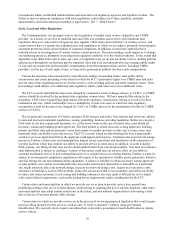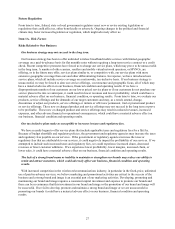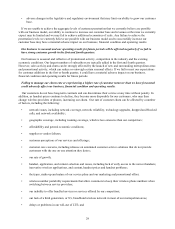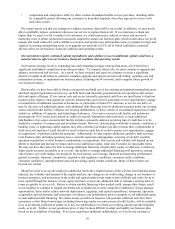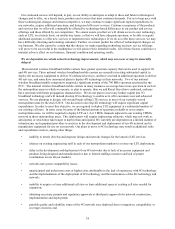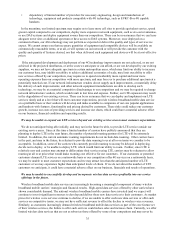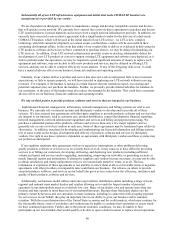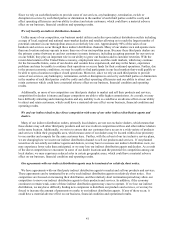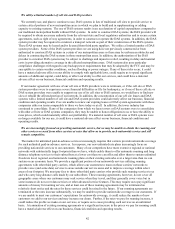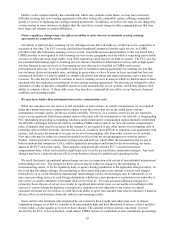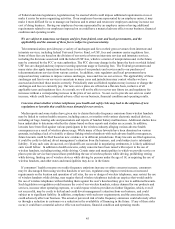Metro PCS 2009 Annual Report Download - page 47
Download and view the complete annual report
Please find page 47 of the 2009 Metro PCS annual report below. You can navigate through the pages in the report by either clicking on the pages listed below, or by using the keyword search tool below to find specific information within the annual report.35
• dependency of limited number of providers for necessary engineering, design and manufacture of
technology, equipment and products compatible with 4G technology, such as EVRC-B or 4G capable
handsets.
In the meantime, our limited spectrum may require us to lease more cell sites to provide equivalent service, spend
greater capital compared to our competitors, deploy more expensive network equipment, such as six-sector antennas,
or use DAS systems and deploy equipment sooner than our competitors. There can be no assurance that we can lease
adequate tower sites or additional spectrum or have access to DAS systems. Moreover, once deployed on a
commercial basis, our 4G technology may not perform as expected or deliver the quality and types of services we
expect. We cannot assure you that necessary quantities of equipment and compatible devices will be available on
commercially reasonable terms, or at all, or will operate on our network or will provide the customer with the
quality and quantity of features desired, nor that when delivered such equipment and devices will be at cost-effective
prices.
If the anticipated development and deployment of our 4G technology improvements are not achieved, or are not
achieved in the projected timeframes, or at the costs we anticipate or can afford, or are not developed by our existing
suppliers, we may not have adequate spectrum in certain metropolitan areas, which may limit our ability to increase
our customer base, may inhibit our ability to achieve additional economies of scale, may limit our ability to offer
new services offered by our competitors, may require us to spend considerably more capital and incur more
operating expenses than our competitors with more spectrum, and may force us to purchase additional spectrum at a
potentially material cost. If our network infrastructure vendors do not supply such improvements, or materially delay
the delivery of such improvements, and other network equipment manufacturers are able to develop such
technology, we may be at a material competitive disadvantage to our competitors and we may be required to change
network infrastructure vendors, which would result in lost time and expense. Further, our LTE expansion may result
in the degradation of our existing services. There can be no assurance that we can deploy and implement our LTE
services timely and at a level that will meet customer expectations, provide wireless broadband mobile data service
on a profitable basis or that vendors will develop and make available to companies of our size popular applications
and handsets with features, functionality and pricing desired by customers. These risks could reduce our customer
growth, increase our costs of providing services and increase our churn, which could have a material adverse effect
on our business, financial condition and operating results.
We may be unable to expand our LTE services beyond our existing service area to meet customer expectations.
We do not anticipate being able initially, and may not in the future be able, to provide LTE service outside our
existing service areas. Since at this time a limited number of carriers have publicly announced that they are
planning to deploy LTE in the near future, the number of potential roaming partners for LTE will be extremely
limited. In addition, the current automatic roaming requirements do not include data roaming. Other carriers have
in the past, and may in the future, be reluctant to provide data roaming to us at all or on terms we consider to be
acceptable. In addition, some of the carriers who currently provide roaming to us may be delayed in deploying,
decide not to deploy, or be unable to deploy LTE, which would limit our ability to roam. Further, since LTE is
relatively new and carriers may attempt to differentiate their services using LTE, carriers may be reluctant to allow
roaming at all or at prices that would make roaming cost effective for our customers. If our customers or potential
customers demand LTE services on a nationwide basis or our competitors offer 4G services on a nationwide basis,
we may be unable to meet customer expectations and we may attract less than the anticipated number of LTE
customers or we may experience higher than anticipated levels of churn. If we do not attract the number of LTE
customers we anticipate, it could have a material adverse effect on our business, financials and results of operations.
We may be unable to successfully develop and incorporate wireless data services profitably into our service
offerings in the future.
Wireless broadband mobile data services are increasingly becoming a meaningful component of many wireless
broadband mobile carriers’ strategies and financial results. High-speed data services offered by other carriers have
shown considerable demand. The national wireless broadband mobile carriers have invested (and we expect will
continue to invest) significant resources to develop and deliver these new data services to their customers. As market
prices for wireless voice services continue to decline, if we are unable to offer such new data services or offer such
services on competitive terms, we may not have sufficient revenue to offset the decline in wireless voice revenues.
Similarly, as customers increasingly demand wireless broadband mobile data services as part of the core feature set
of their wireless services, the failure to offer such services could reduce sales and increase churn. Currently, we offer
limited wireless data services that are not as robust as those offered by some of our competitors and may never be.



